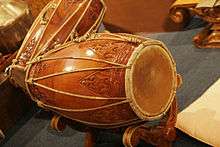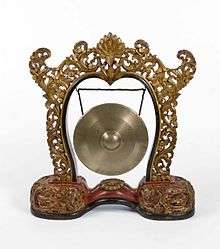Kendang
Kendang (Javanese: ꦏꦼꦤ꧀ꦝꦁ, romanized: Kendhang Tausug/Bajau Maranao: Gandang) is a two-headed drum used by peoples from Maritime Southeast Asia. Kendang is one of the primary instruments used in the Gamelan ensembles of Javanese, Sundanese, Balinese and Terengganu, the Kendang ensemble as well as various Kulintang ensembles in Indonesia, Malaysia, Singapore, Brunei, and the Philippines. It is constructed in a variety of ways by different ethnic groups.
| Gamelan ensemble | |
|---|---|
| Stylistic origins | Music of Indonesia ( Java and Bali ) |
| Cultural origins | Indonesia |
| Typical instruments | Gamelan • Gong • Bonang • Gambang • Gendèr • Kemanak • Kendang • Kepyak • Reyong • Gangsa • Kenong/Kethuk • Peking • Saron • Siter • Slenthem • Suling |

Overview

The typical double-sided membrane drums are known throughout Maritime Southeast Asia and India. One of the oldest image of kendang can be found in ancient temples in Indonesia, especially the ninth century Borobudur and Prambanan temple.
Among the Javanese, Sundanese, or Malay peoples, the kendang has one side larger than the other, with the larger, lower-pitched side usually placed to the right, and are usually placed on stands horizontally and hit with the hands on either side while seated on the floor. Amongst groups like the Balinese, Tausug, and Maranao, both sides are of equal size, and are played on either one or both sides using a combination of hands and/or sticks.
Within Gamelan, the kendang is smaller than the bedug, which is placed inside a frame, hit with a beater, but used less frequently. The kendang usually has the function of keeping the tempo (Laya) while changing the density (Irama), and signaling some of the transitions (paralihan) to sections and the end of the piece (suwuk).
In dance or wayang, the kendang player will follow the movements of the dancer, and communicate them to the other players in the ensemble. In West Java, kendang are used to keep the tempo of Gamelan Degung. Kendang are also used as main instrument for Jaipongan dances. In another composition called Rampak Kendang, a group of drummers play in harmony.
Kendang making
Good kendang instruments are said to be made from the wood of jackfruit, coconuts or cempedak. Buffalo hide is often used for the bam (inferior surface which emits low-pitch beats) while soft goatskin is used for the chang (superior surface which emits high-pitch beats).
The skin is stretched on y-shaped leather or rattan strings, which can be tightened to change the pitch of the heads. The thinner the leather the sharper the sound.
Accompaniments

In Gamelan Surakarta, four sizes of kendhang are used:[1] [2]
- Kendhang ageng, kendhang gede (krama/ngoko, similar to gong ageng in usage), or kendhang gendhing is the largest kendang, which usually has the deepest tone. It is played by itself in the kendhang satunggal (lit. "one drum") style, which is used for the most solemn or majestic pieces or parts of pieces. It is played with the kendhang ketipung for kendhang kalih (lit. "two drum") style, which is used in faster tempos and less solemn pieces.
- Kendhang wayang is also medium-sized, and was traditionally used to accompany wayang performances, although now other drums can be used as well.
- Kendhang batangan or kendhang ciblon[3]is a medium-sized drum, used for the most complex or lively rhythms. It is typically used for livelier sections within a piece. The word ciblon derives from a Javanese type of water-play, where people smack the water with different hand shapes to give different sounds and complex rhythms. The technique of this kendang, which is said to imitate the water-play,[4] is more difficult to learn than the other kendang styles.
- Kendhang ketipung is the smallest kendang, used with the kendang ageng in kendhang kalih style.
In Bali Gamelan, there are two kendang:[5]
- Kendang wadon, the "female" and lowest pitched.
- Kendang lanang, the "male" and highest pitched.
See also
Sources
- http://www.seasite.niu.edu/indonesian/budaya_bangsa/Gamelan/Javanese_Gamelan/drums/kendang.htm
- jv:Kendhang
- https://omeka1.grinnell.edu/MusicalInstruments/exhibits/show/ens/item/82
- Lindsay, Jennifer (1992). Javanese Gamelan, p.22. ISBN 0-19-588582-1. "The technique of kendang ciblon is very difficult to acquire. 'Ciblon' is the Javanese name for a type of water-play, popular in villages, where a group of people, through smacking the water with different hand-shapes, produce complex sounds and rhythmic patterns. These sounds are imitated on the dance drum."
- "Archived copy". Archived from the original on 2012-11-03. Retrieved 2019-10-20.CS1 maint: archived copy as title (link)
Further reading
- Sumarsam. Javanese Gamelan Instruments and Vocalists. 1978-1979.
.jpg)
